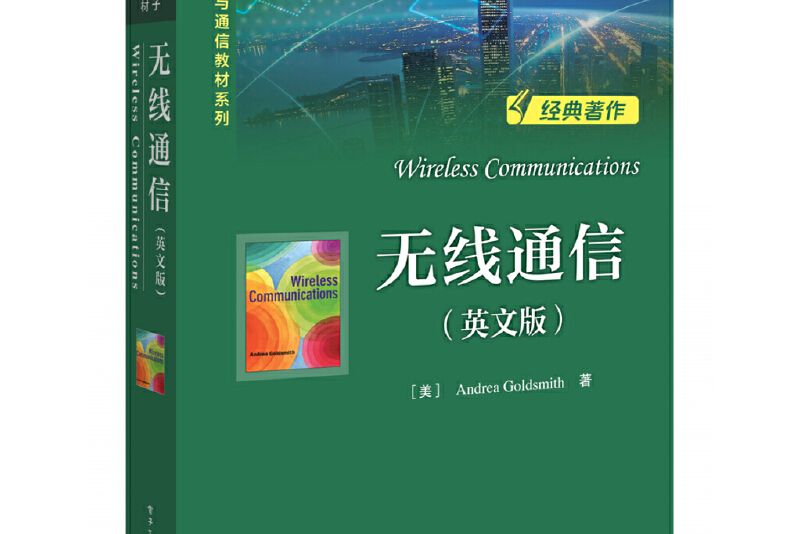內容簡介
本書是無線通信領域的一本優秀的經典教材,介紹了無線通信的基本原理,重點論述了無線通信系統的基本理論與設計分析方法。全書內容包括無線信道模型、無線信道容量、無線通信中的調製編碼技術及均衡處理技術、分集、擴頻通信,還包括多天線系統、多用戶系統、多載波調製、自適應調製與編碼、蜂窩系統及無線自組織網路等。影印版製作時已根據配套網站提供的勘誤表(2006年版)對內容進行了更正。
圖書目錄
1 Overview of Wireless Communications 無線通信概述
1.1 History of Wireless Communications 無線通信的歷史
1.2 Wireless Vision 無線願景
1.3 Technical Issues 技術問題
1.4 Current Wireless Systems 現有無線系統
1.4.1 Cellular Telephone Systems 蜂窩電話系統
1.4.2 Cordless Phones 無繩電話系統
1.4.3 Wireless Local Area Networks 無線區域網路
1.4.4 Wide Area Wireless Data Services 廣域無線數據業務
1.4.5 Broadband Wireless Access 寬頻無線接入
1.4.6 Paging Systems 尋呼系統
1.4.7 Satellite Networks 衛星通信網
1.4.8 Low-Cost, Low-Power Radios: Bluetooth and ZigBee 低成本、低功率的無線通信:藍牙和紫蜂
1.4.9 Ultrawideband Radios 超寬頻無線通信
1.5 The Wireless Spectrum 無線頻譜
1.5.1 Methods for Spectrum Allocation 頻譜的分配方式
1.5.2 Spectrum Allocations for Existing Systems 現有系統的頻譜分配
1.6 Standards 標準
Problems 習題
References 參考文獻
2 Path Loss and Shadowing 路徑損耗和陰影衰落
2.1 Radio Wave Propagation 無線電波傳播
2.2 Transmit and Receive Signal Models 傳送和接收信號模型
2.3 Free-Space Path Loss 自由空間路徑損耗
2.4 Ray Tracing 射線跟蹤
2.4.1 Two-Ray Model 兩徑模型
2.4.2 Ten-Ray Model (Dielectric Canyon) 十徑模型(介電峽谷)
2.4.3 General Ray Tracing 通用射線跟蹤
2.4.4 Local Mean Received Power 本地平均接收功率
2.5 Empirical Path-Loss Models 經驗路徑損耗模型
2.5.1 Okumura Model 奧村模型
2.5.2 Hata Model 哈塔模型
2.5.3 COST 231 Extension to Hata Model 哈塔模型的COST 231擴展
2.5.4 Piecewise Linear (Multislope) Model 折線(多斜率)模型
2.5.5 Indoor Attenuation Factors 室內衰減因子
2.6 Simplified Path-Loss Model 簡化的路徑損耗模型
2.7 Shadow Fading 陰影衰落
2.8 Combined Path Loss and Shadowing 路徑損耗和陰影衰落的混合模型
2.9 Outage Probability under Path Loss and Shadowing 路徑損耗和陰影衰落造成的中斷率
2.10?Cell Coverage Area 小區覆蓋範圍
Problems 習題
References 參考文獻
3 Statistical Multipath Channel Models 統計多徑信道模型
3.1 Time-Varying Channel Impulse Response 時變信道的衝激回響
3.2 Narrowband Fading Models 窄帶衰落模型
3.2.1 Autocorrelation, Cross-Correlation, and Power Spectral Density 自相關、互相關和功率譜密度
3.2.2 Envelope and Power Distributions 包絡和功率分布
3.2.3 Level Crossing Rate and Average Fade Duration 電平通過率和平均衰落時長
3.2.4 Finite-State Markov Channels 有限狀態馬爾可夫信道
3.3 Wideband Fading Models 寬頻衰落模型
3.3.1 Power Delay Profile 功率時延譜
3.3.2 Coherence Bandwidth 相干頻寬
3.3.3 Doppler Power Spectrum and Channel Coherence Time 都卜勒功率譜和信道相干時間
3.3.4 Transforms for Autocorrelation and Scattering Functions 自相關和散射函式的變換
3.4 Discrete-Time Model 離散時間模型
3.5 Space-Time Channel Models 空時信道模型
Problems 習題
References 參考文獻
4 Capacity of Wireless Channels 無線信道的信道容量
4.1 Capacity in AWGN AWGN信道容量
4.2 Capacity of Flat Fading Channels 平坦衰落信道的容量
4.2.1 Channel and System Model 信道和系統模型
4.2.2 Channel Distribution Information Known 信道分布信息已知
4.2.3 Channel Side Information at Receiver 接收端已知CSI
4.2.4 Channel Side Information at Transmitter and Receiver 收發兩端都已知CSI
4.2.5 Capacity with Receiver Diversity 接收分集的信道容量
4.2.6 Capacity Comparisons 容量對比
4.3 Capacity of Frequency-Selective Fading Channels 頻率選擇性衰落信道的容量
4.3.1 Time-Invariant Channels 時不變信道
4.3.2 Time-Varying Channels 時變信道
Problems 習題
References 參考文獻
5 Digital Modulation and Detection 數字調製與檢測
5.1 Signal Space Analysis 信號空間分析
5.1.1 Signal and System Model 信號與系統模型
5.1.2 Geometric Representation of Signals 信號的幾何表示
5.1.3 Receiver Structure and Sufficient Statistics 接收機結構和充分統計量
5.1.4 Decision Regions and the Maximum Likelihood Decision Criterion 判決域和最大似然判決準則
5.1.5 Error Probability and the Union Bound 誤碼率和聯合界
5.2 Passband Modulation Principles 帶通調製原理
5.3 Amplitude and Phase Modulation 幅度/相位調製
5.3.1 Pulse Amplitude Modulation (MPAM) 脈衝幅度調製
5.3.2 Phase-Shift Keying (MPSK) 相移鍵控
5.3.3 Quadrature Amplitude Modulation (MQAM) 正交幅度調製
5.3.4 Differential Modulation 差分調製
5.3.5 Constellation Shaping 星座成形
5.3.6 Quadrature Offset 正交偏移
5.4 Frequency Modulation 頻率調製
5.4.1 Frequency-Shift Keying (FSK) and Minimum-Shift Keying (MSK) 頻移鍵控和最小頻移鍵控
5.4.2 Continuous-Phase FSK (CPFSK) 連續相位頻移鍵控
5.4.3 Noncoherent Detection of FSK FSK的非相干檢測
5.5 Pulse Shaping 脈衝成形
5.6 Symbol Synchronization and Carrier Phase Recovery 碼元同步和載波相位恢復
5.6.1 Receiver Structure with Phase and Timing Recovery 具有相位和定時恢復的接收機結構
5.6.2 Maximum Likelihood Phase Estimation 最大似然相位估計
5.6.3 Maximum Likelihood Timing Estimation 最大似然定時估計
Problems 習題
References 參考文獻
6 Performance of Digital Modulation over Wireless Channels 無線信道中數字調製的性能
6.1 AWGN Channels AWGN信道
6.1.1 Signal-to-Noise Power Ratio and Bit /Symbol Energy 信噪比和比特/符號能量
6.1.2 Error Probability for BPSK and QPSK BPSK和QPSK的差錯機率
6.1.3 Error Probability for MPSK MPSK的差錯機率
6.1.4 Error Probability for MPAM and MQAM MPAM和MQAM的差錯機率
6.1.5 Error Probability for FSK and CPFSK FSK和CPFSK的差錯機率
6.1.6 Error Probability Approximation for Coherent Modulations 相干調製的差錯機率的近似
6.1.7 Error Probability for Differential Modulation 差分調製的差錯機率
6.2 Alternate Q-Function Representation Q函式的一種等效表示法
6.3 Fading 衰落信道
6.3.1 Outage Probability 中斷率
6.3.2 Average Probability of Error 平均差錯機率
6.3.3 Moment Generating Function Approach to Average Error Probability 用矩母函式求平均差錯機率
6.3.4 Combined Outage and Average Error Probability 中斷率和平均差錯機率的結合
6.4 Doppler Spread 都卜勒頻移
6.5 Intersymbol Interference 碼間干擾
Problems 習題
References 參考文獻
7 Diversity 分集
7.1 Realization of Independent Fading Paths 獨立衰落路徑的實現
7.2 Receiver Diversity 接收分集
7.2.1 System Model 系統模型
7.2.2 Selection Combining 選擇合併
7.2.3 Threshold Combining 閾值合併
7.2.4 Maximal-Ratio Combining 最大比合併
7.2.5 Equal-Gain Combining 等增益合併
7.3 Transmitter Diversity 傳送分集
7.3.1 Channel Known at Transmitter 傳送端已知信道
7.3.2 Channel Unknown at Transmitter ?C The Alamouti Scheme 傳送端未知信道(Alamouti方案)
7.4 Moment Generating Functions in Diversity Analysis 利用矩母函式分析分集
7.4.1 Diversity Analysis for MRC MRC分集的分析
7.4.2 Diversity Analysis for EGC and SC EGC和SC分集的分析
7.4.3 Diversity Analysis for Noncoherent and Differentially Coherent Modulation 非相干和差分相干調製時分集系統的性能分析
Problems 習題
References 參考文獻
8 Coding for Wireless Channels 無線信道中的編碼
8.1 Overview of Code Design 碼設計概述
8.2 Linear Block Codes 線性分組碼
8.2.1 Binary Linear Block Codes 二進制線性分組碼
8.2.2 Generator Matrix 生成矩陣
8.2.3 Parity-Check Matrix and Syndrome Testing 校驗矩陣與伴隨式
8.2.4 Cyclic Codes 循環碼
8.2.5 Hard Decision Decoding (HDD) 硬判決解碼
8.2.6 Probability of Error for HDD in AWGN AWGN信道中硬判決解碼的差錯機率
8.2.7 Probability of Error for SDD in AWGN AWGN信道中軟判決解碼的差錯機率
8.2.8 Common Linear Block Codes 常見的線性分組碼
8.2.9 Nonbinary Block Codes: The Reed Solomon Code 多進制分組碼:Reed Solomon碼
8.3 Convolutional C

